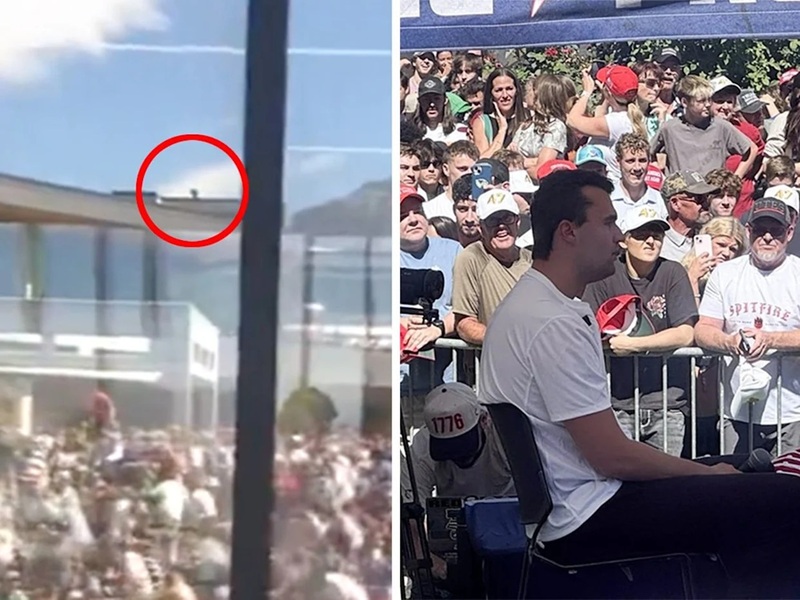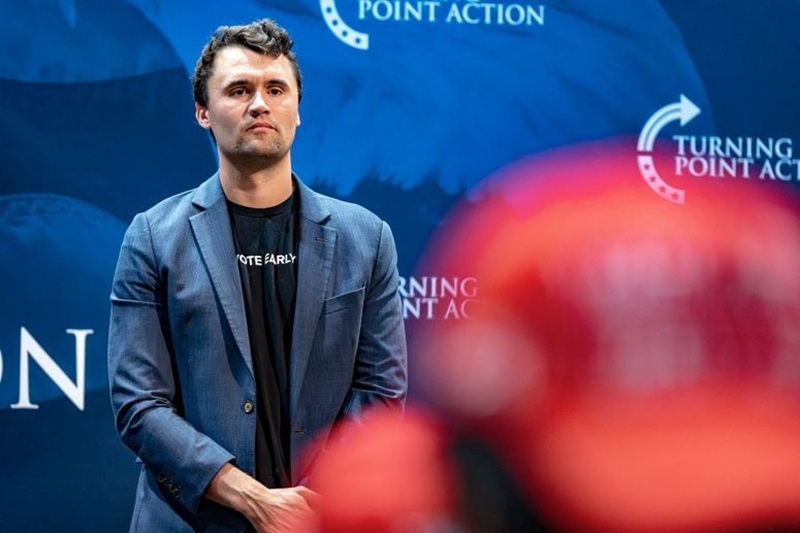The air in Orem, Utah, hung thick with the electric hum of anticipation on that fateful September afternoon. Nearly 3,000 voices—students, activists, everyday folks drawn to the fire of unfiltered conservatism—gathered under a sprawling tent at Utah Valley University. At the center stood Charlie Kirk, the 31-year-old dynamo who’d built Turning Point USA into a juggernaut of youth mobilization, a relentless voice against what he saw as the creeping tide of progressive overreach. With his trademark energy, Kirk was just two questions into a lively Q&A, tossing a red MAGA hat into the crowd like a lifeline to his message of empowerment. Then, in a heartbeat that echoed across the nation, everything shattered.

A single shot cracked the sky at around 12:20 p.m., striking Kirk in the neck. Blood bloomed dark against his collar as he collapsed, the crowd erupting into a whirlwind of screams and shoving bodies. Phones whipped out, capturing the pandemonium in raw, unflinching pixels: Kirk’s team swarming him, lifting his limp form with urgent hands, hustling him toward a waiting black SUV amid a sea of fleeing faces. Within minutes, the vehicle vanished eastward, not toward the public hospital a scant mile away, but to the hushed corridors of Clearview Medical—a private enclave whispered about in elite circles for its veil of discretion. No ambulances wailed in response. No paramedics breached the perimeter. Just a ghosting exit that left bystanders blinking in stunned silence.
In the hours that followed, the story solidified into a gut-wrenching portrait of lone-wolf terror. Authorities fingered 22-year-old Tyler Robinson, a politically charged drifter from a nearby neighborhood, as the rooftop sniper. Grainy surveillance footage showed a black-clad figure scrambling down from the Losee Center building, bolt-action rifle in tow, melting into the wooded fringes before vanishing. Federal agents recovered the weapon, palm prints, and footprints, piecing together a narrative of targeted rage: Robinson, radicalized online against Kirk’s staunch pro-life, pro-Second Amendment rhetoric, had allegedly stalked the event for days. Aggravated murder charges landed swiftly, with prosecutors eyeing the death penalty. The nation mourned—a conservative icon cut down in his prime, his wife Erika stepping tearfully into the breach to carry Turning Point’s torch.

But as the shockwaves rippled, so did the cracks in the facade. Within days, anonymous uploads to encrypted forums began to stir the digital underbelly. A 27-second clip, shaky and low-res, purportedly from a student’s phone, looped endlessly: Kirk mid-gesture, a uniformed guard to his left executing a crisp wrist flick toward the rear exit. Three heartbeats later, the shot. Kirk’s chief aide—recognizable by a gleaming lapel pin—had pivoted moments earlier, offering a single, deliberate nod to the same guard. The crowd didn’t just scatter; they funneled, almost as if herded by invisible lines. “Watch the synchronization,” urged Raymond Holbrook, a grizzled independent security consultant with two decades in high-stakes extractions. In a no-frills Zoom breakdown that racked up millions of views, Holbrook froze the frames: Guards bracing postures before the bang, aides scanning not in panic but preparation. “That’s not fight-or-flight. That’s flowchart. You don’t drill civilians to peel left on a dime unless you’ve walked this beat before.”
The internet, ever the relentless archivist, dubbed it “The Signal No One Saw.” Slow-motion enhancements caught what ears strained to hear: a faint murmur amid the prelude hum—”Standby. Cue in three.” If real, those words weren’t ad-libbed; they were stage directions. Skeptics piled on, but the anomalies mounted like storm clouds. Why the SUV’s detour to Clearview, a facility better suited for discreet Botox touch-ups than gunshot trauma? Dr. Angela Pruitt, an ER veteran from Salt Lake’s Intermountain Medical Center, didn’t mince words in a podcast that went viral: “Real emergencies demand the nearest trauma bay—lights, sirens, full protocol. Bypassing that? It’s not caution; it’s calculus. Someone wanted zero paper trail, no mandatory reports. That’s concealment 101.” Eyewitness accounts trickled in via Reddit threads and X rants: No medevac choppers overhead, no police cordons snapping into place until well after the SUV’s taillights faded. One student, posting under the handle @UVUTruthSeeker, claimed to have seen Kirk’s detail barking orders with military clip, corralling gawkers away from the tent while pocketing what looked like mic packs and stray cables—disturbing a crime scene still warm with fresh evidence.

Then came the blackout that truly ignited the firestorm. The official Turning Point live stream—broadcast to tens of thousands—suffered a glaring void: nearly two minutes excised, timestamped to overlap the signal, the shot, the sprint. Analysts, from amateur sleuths wielding freeware editors to pros at digital forensics firms, labeled it “premeditated pruning.” Who held the scissors? Not a glitch, they argued, but a deliberate scrub by insiders with stream keys. “In live events, gaps like that scream human hand,” noted Eli Warren, a media forensics expert whose thread on the topic drew endorsements from cybersecurity vets. Warren’s deep dive highlighted identical phrasing blooming across sympathetic outlets—”momentary confusion,” “swift professional response”—within 30 minutes of the blast. “That’s not organic spin; that’s a template dropped from a shared drive. Pressers don’t write themselves that fast.”
The timing? Eerily fortuitous. Hours before the event, a blistering financial disclosure had bubbled up on niche finance blogs: allegations of murky dealings in Kirk’s inner circle, ties to opaque donors funneled through shell entities. By dawn the next day, it had plummeted from trending radars, smothered under an avalanche of Kirk tributes. Coincidence? Or choreography? The plot thickened when IronGate Protection, the private firm manning Kirk’s detail that day, pulled a digital vanishing act. Their website? Dark. Socials? Purged. Digging revealed a shared address with a political consultancy notorious for narrative sculpting—crisis comms for the powerful, where scandals get sanded smooth. Holbrook, poring over archived bios, connected dots: IronGate wasn’t just muscle; they were message multipliers, trained in the dark art of controlled chaos.

As November’s chill settled over campuses still scarred by echoes of that shot, the leaked footage metastasized into a movement. Forums buzzed with enhancements: One frame zoomed on the guard’s wrist, revealing a subtle tattoo matching IronGate’s house sigil. Another isolated audio spikes, filtering crowd roar to isolate that ghostly “cue.” Candace Owens, Kirk’s onetime collaborator turned fierce skeptic, amplified the clamor on her podcast, railing against “FBI gatekeeping” of hospital logs and rooftop access cams. “Charlie deserved transparency, not this tomb of redactions,” she thundered, her words rallying a diaspora of doubters from MAGA heartlands to libertarian enclaves. Even mainstream skeptics, like Glenn Greenwald in a blistering Substack, weighed in: “When the gatekeepers clutch evidence like a dirty secret, it’s not protection—it’s provocation.”
Yet amid the frenzy, counter-narratives clashed like thunderheads. Official probes insisted Robinson acted solo, his manifesto—a screed against “fascist enablers” like Kirk—unearthed from a laptop in his fleabag hideout. Fact-checkers at CNN and PBS dismantled viral fakes: That “suspicious” white-capped figure signaling doom? Just Frank Turek, Kirk’s radio host pal, clutching his phone in shock. The hand gestures? Veteran cops confirmed them as standard sweeps—cap adjusts for better sightlines, arm scans for perimeters. Andrew Kolvet, executive producer of The Charlie Kirk Show, fired back at smears on chief aide Mikey McCoy: “He was filming for our chat, ears plugged against the blast—shell-shocked, not sinister.” Erika Kirk, now helming Turning Point with quiet steel, penned an op-ed in The Wall Street Journal: “My husband’s murder was a wound to us all. Let’s honor him by rejecting shadows, not chasing them.”
But the shadows lingered, stubborn as smoke. Why did a detective on scene let Kirk’s crew yank SD cards from event cams a mere nine minutes post-shot—tampering that forensics labs later decried as “catastrophic contamination”? Bodycam snippets, pried loose via FOIA, showed the same officer tagging a stray holstered handgun amid the tent’s debris, yet no follow-up on its provenance. Bystander vids captured “security goons” in tactical vests—boots thudding, hands rifling—trampling the hot zone, pocketing glints of metal while shooing civilian recorders. One clip, timestamped 12:28 p.m., freezes on Terryl Farnsworth, a TPUSA videographer, snapping a selfie amid the scrum, his face a mask of rehearsed grief as Kirk’s form is borne away. “They shot Charlie—he’s gone,” Farnsworth mutters to his screen, the words tumbling out before medics even feigned arrival. Gaslighting or gut instinct? The debate raged, fracturing alliances in real time.

Two months on, as Turning Point’s campus tour wrapped in a riot-torn UC Berkeley—Antifa clashing with cops outside a memorial event, bottles flying like accusations—the ghost of that Utah tent loomed larger. Protesters in keffiyehs hurled chants of “No kings on the hill,” while attendees, bloodied but unbowed, waved Kirk’s visage on smartphones. Inside, speakers eulogized a martyr; outside, the air crackled with the same unease that birthed the leaks. Was it a flawless hit by a deranged ideologue, or a psyop masterpiece—diversion for deeper games, where Kirk’s death drowned scandals and unified a fracturing right? Holbrook, sipping black coffee in a nondescript diner, put it plain: “Real hits leave loose threads. This? It’s knotted too neat.”
The emotional toll defies metrics. Families like the Kirks grapple with voids no footage fills—Erika’s voice cracking in interviews, her resolve a fragile armor against conspiracy’s cruel churn. Fans, once galvanized by Kirk’s calls to “own the libs,” now splinter: Some double down on vengeance, petitions flooding for Patel’s FBI to “unseal the vault”; others, weary of the witch hunt, plead for peace. Warren, the forensics whiz, warns of the bigger bleed: “In an era of deepfakes and drone drops, trust is the first casualty. This video doesn’t just question one death—it interrogates every feed we swallow.”
As winter bites, the question hangs heavier than Utah’s mountain air: Chaos or cue? Tragedy or tactic? The grainy 27 seconds, that wrist’s whisper, the scrubbed stream—they’ve cracked open a fault line in America’s fractured mirror. Charlie Kirk, the kid who turned college quads into battlegrounds, might have smirked at the irony: In death, as in life, he’s forcing us to question not just the messengers, but the very script we live by. The message? Crystal amid the static: In the theater of power, nothing’s spontaneous. And the house lights? They’ve yet to come up.

